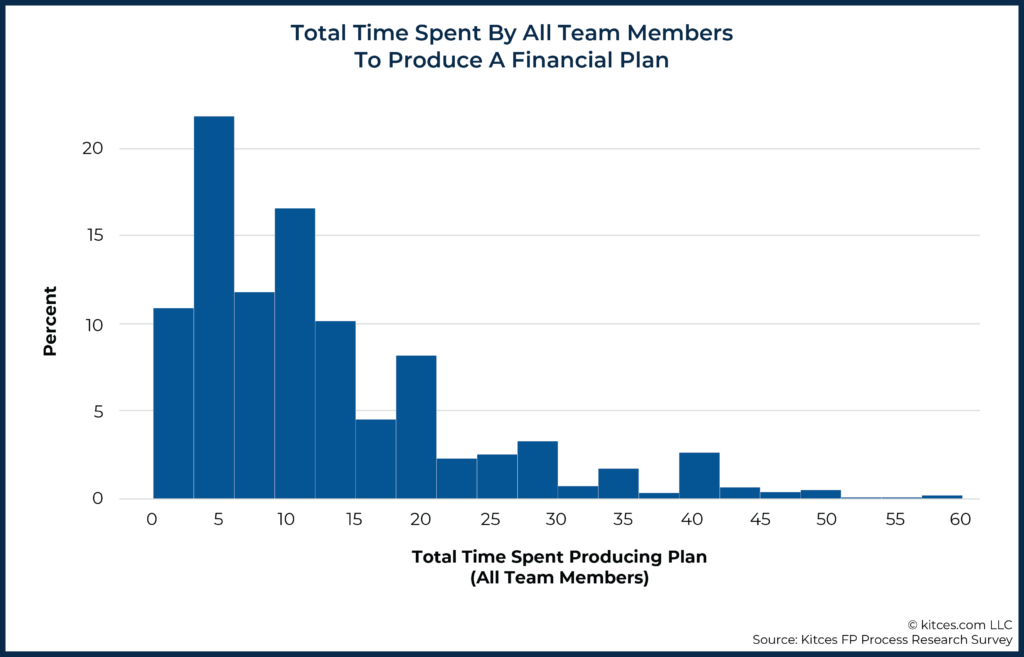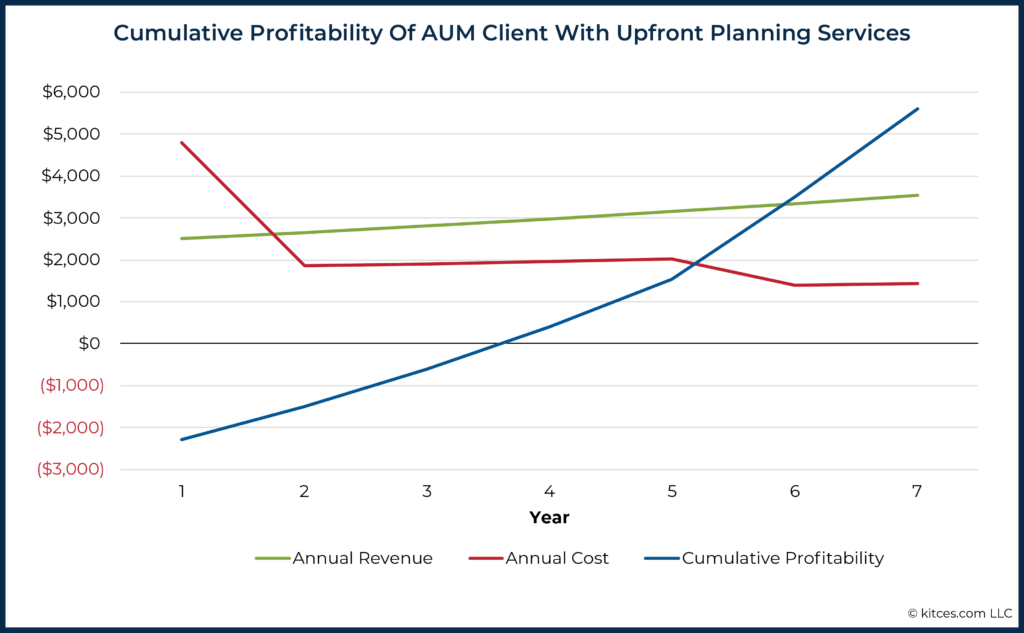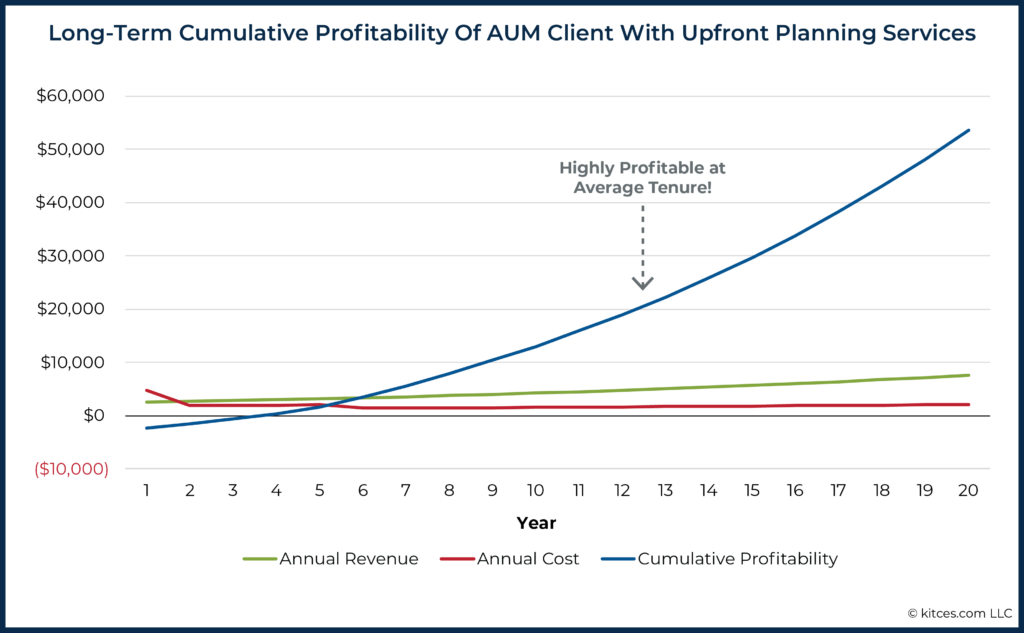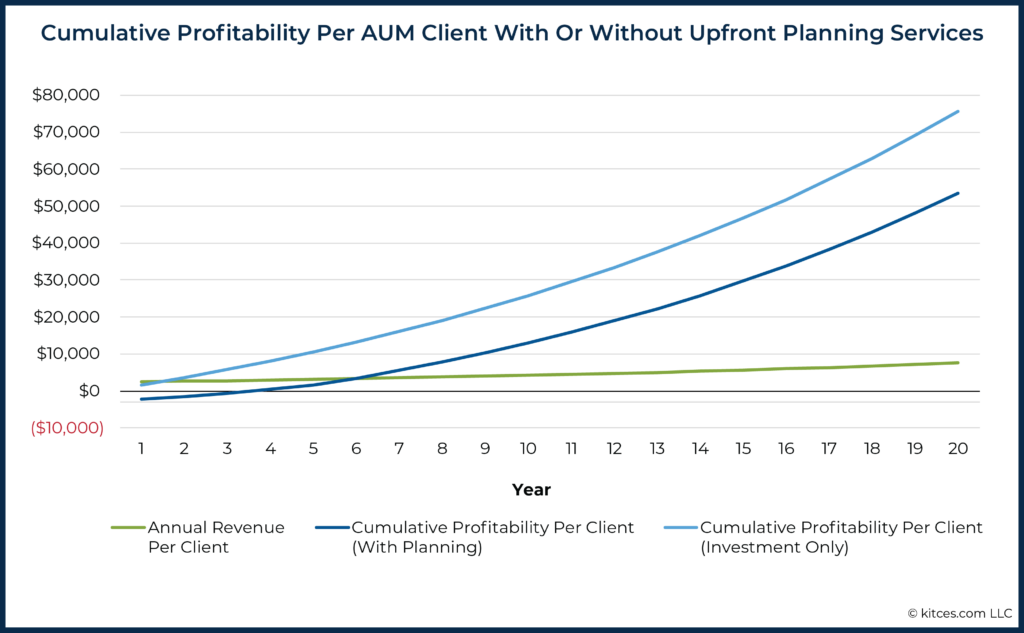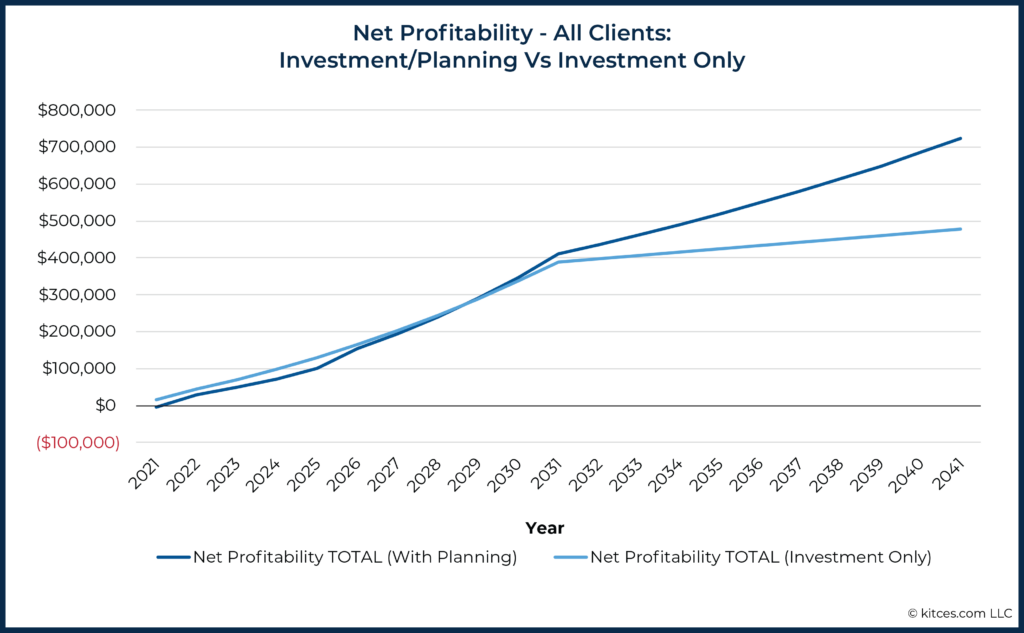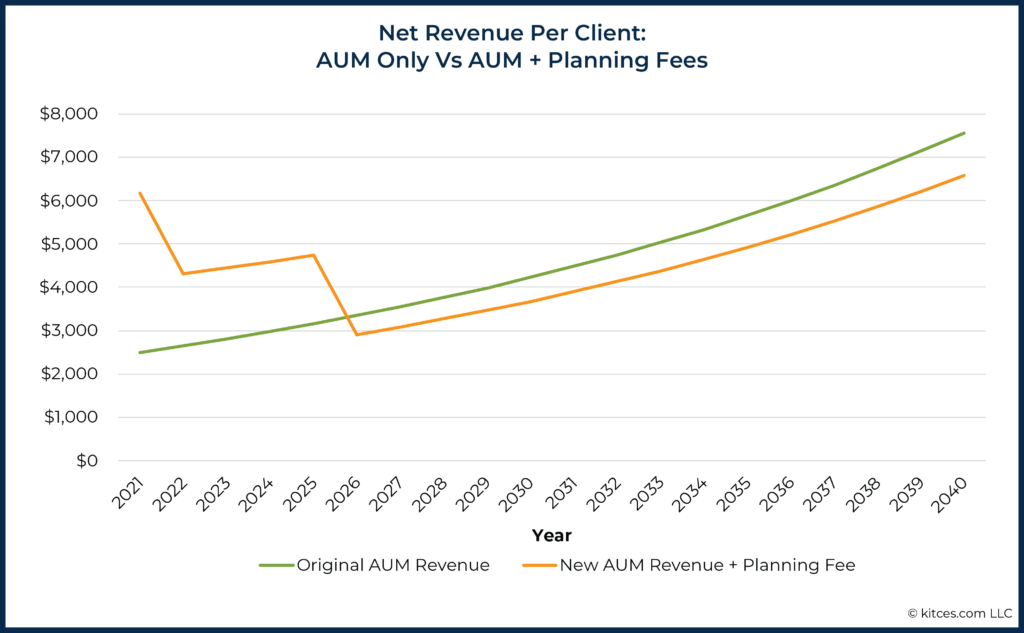Executive Summary
Providing financial planning services takes time. A lot of time. In fact, according to a recent Kitces Research study, the average advisory firm spends 10 hours just constructing a financial plan, and more than 30 hours across the firm servicing a client throughout the first year to gather data, analyze and produce a financial plan, deliver it to the client, implement the recommendations, and begin the ongoing monitoring process. Which means, not surprisingly, that it’s often necessary to charge clients a non-trivial financial planning fee upfront to recover the time investment. Especially as financial advisors are increasingly shifting to AUM fees and other recurring revenue fee-for-service models, rather than earning a (potentially sizable) upfront commission for the products implemented after the plan is delivered.
Yet the reality is that with the rise of AUM and subscription models in particular, along with their recurring revenue potential, it’s actually not necessary to charge upfront for time-consuming financial planning to get paid for it. Instead, as long as delivering financial planning still provides value, deepens the advisor-client relationship, and, most importantly (from the business perspective), improves long-term retention, it’s entirely possible to be ‘paid well’ for financial planning without charging for it separately at all! Because even a relatively small improvement in client retention rates can produce a very sizable Return On Investment (ROI) for putting in the time and effort to do the financial planning in the first place.
In fact, charging separately for financial planning (and maintaining lower ongoing fees once the upfront planning work is completed) actually introduces the risk that clients will have ‘sticker shock’ about the upfront cost and will choose not to purchase it at all, which means, ironically, that charging for financial planning can actually reduce the number of clients who engage in it. By contrast, bundling financial planning into an AUM or subscription fee changes the client psychology, subtly encouraging clients to take advantage of the service by making it already included… knowing that clients who do engage in financial planning will be more likely to stick around for the long run anyway.
On the other hand, there is a simple appeal to the ‘purity’ of having clients pay for financial planning at the time they receive financial planning, and keeping costs and fees more directly aligned in each and every year. Nonetheless, the reality across a wide range of industries is that it’s quite common to bundle services together, in a manner that makes some clients more profitable and others less so in any particular year, as long as it averages out over time. And at least with a recurring revenue model, it’s the client’s less-time-intensive years that help to cross-subsidize the more-time-intensive ones (and with retention rates for ongoing financial planning firms approaching 98%, most clients appear to be quite comfortable with that reality!).
Of course, it’s still impossible to offer ‘free’ financial planning, paid for with AUM or subscription fees over time, for clients who don’t have assets to manage in the first place; for those clients, a fee-for-service model where clients pay directly for financial planning is the only option. Yet for those who do have other means to pay, and other business models to reach them, it’s important to recognize how an advisory firm really can ‘give away’ financial planning and still be paid well for their efforts over time… at least for firms that have the confidence in their client retention and the patience to grow profitability over time!?
The Labor-Intensive Cost Of Financial Planning
One of the fundamental challenges of delivering financial planning to consumers is that it’s time intensive. For most financial planners, the process involves at least two lengthy client meetings – one for data gathering and discovery, and a second to actually present ‘the plan’ – that can take two hours each. Often there’s at least one additional follow-up meeting for implementation and initial monitoring in the first year. And then there’s the time to actually construct the financial plan itself, which a recent Kitces Research study showed is more than 10 hours for 50% of advisors. Which means all-in, the majority of financial planners spend at least 15 hours gathering data in meetings, analyzing and constructing the financial plan, and delivering the financial plan to the client.
And given the reality that this is time being spent by trained professional financial planning staff, the result is a substantial staff/labor cost needed to produce and deliver a financial plan. Even if we assume that 2/3rds of the 15-hour cumulative effort is done by a ‘lead’ advisor, and the 1/3rd is delegated to a paraplanner or support advisor, then, given financial advisor compensation of $200,000/year for an experienced lead advisor (the equivalent of $100/hour assuming 2,000 working hours in a year) and $60,000 for a paraplanner (equal to $30/hour), a conservative estimate of the raw time-is-money cost to produce a financial plan is about $1,150 (and with the cost of financial planning software, and other operational overhead, rises even further). Which helps to explain why the retail cost of a financial plan for consumers often starts at $1,000 and rises from there (with a median of $2,500 as the advisor charges a $250+/hour rate to cover their time and their staff cost).
The time-intensive nature of financial planning also helps explain why it is increasingly popular for financial planners to charge standalone financial planning fees blended alongside their commissions or AUM fees over the past decade. Because the more in-depth the financial planning becomes – as the industry evolves away from its product-sales roots and towards more comprehensive financial plans – the more time-intensive the initial process of building a financial plan becomes, which introduces a real hard-dollar staff/labor cost for the advisory firm if the financial plan doesn’t pan out in a new client that follows through on implementation.
In other words, when a financial plan was commonly delivered as the lead-in to a product sale, the more substantial upfront product commission could help to cover not only the cost of the plan, but even the cost of plans to other clients that didn’t implement.
For instance, if a plan was going to lead to a $250,000 rollover into an A-share mutual fund paying a 4% commission load – which would result in $10,000 of compensation to the advisor at the conclusion of the 2-3 meeting planning process – it wasn’t necessary to charge much (or at all) for the financial plan, because the planning time was amply compensated by the subsequent product sale. In fact, even if a few clients never implemented at all, it was still financially worthwhile to ‘give the plan away’, because there would be enough commission generated from 1 client who actually implemented the plan, out of every 4, to still average out with profitable financial planning (as averaging $10,000 ÷ 4 = $2,500 of revenue per client would be more than enough to cover the cost of only $1,150 per plan).
On the other hand, as the popularity of commission-based compensation has declined, and AUM and even subscription models have risen, the metrics have also changed. Now, a $250,000 rollover results in a ‘mere’ $625 fee (assuming a 1% AUM fee, payable quarterly to the advisor) that isn’t even paid until a few months after the client actually engages. Which substantially increases the risk to the advisory firm, as if the planning work is done and the client does not implement, it’s hard to make up the $1,150 cost of the financial planning work with the next client who pays only $625 in 3 months!
If the advisor delivers four financial plans but only gets one actual client out of it, the advisor is still averaging $1,150 per plan in cost ($4,600 total), but now only receives $2,500 in advisory fees from one client. And since only $625 in total revenue is received from that client each quarter, the equivalent of $625 (first quarterly payment from the one engaging client) ÷ 4 (clients receiving financial plans) = $156 per client in revenue is received in the first quarter for the four plans (at a cost of $1,150 each!) that were delivered over the first year! Oof.
Yet it’s crucial to recognize that, from the business perspective, there’s still a substantial opportunity to ‘make up’ the cost of delivering (time-consuming) financial planning upfront, even without charging separately for it.
The Long-Term Profitability Of Recurring Revenue Clients Over Time
The interesting phenomenon of AUM or subscription models is that, unlike earning upfront commissions (with little in ongoing trails or sometimes nothing at all thereafter), they provide ongoing, recurring revenue. And in the event that clients stay on board for the long run, even clients that initially seem unprofitable (due to time-intensive upfront financial planning or portfolio management work) do average out and turn profitable eventually.
For instance, imagine an advisor who charges a 1% AUM fee, and is working with a new client who has a $250,000 portfolio. Due to the complexity of the client’s situation, the advisor spends an (industry average) of almost 32 hours going through all the financial planning (and investment portfolio) meetings with the client over the span of the entire first year. As the financial planning and investment implementation challenges are slowly solved, though, the time commitment falls, to an average of just 12 hours per year in years 2-5, and then eventually declines further to an average of just 8 hours/year (2 client meetings per year, plus some behind-the-scenes office, prep, and follow-up work) in years 6 and beyond.
Assuming the client’s portfolio grows at 6%/year, and the advisor’s raw time (plus support staff and overhead expenses) costs $150/hour in salary costs (inflating at 3%/year for cost-of-living adjustments), the revenue, expense, and long-term profitability of this client relationship is shown below.
Cumulatively over time, this is an important dynamic – even “unprofitable” clients with intense up-front work obligations do eventually become profitable. With a long enough time horizon – e.g., for those clients who stick around for a decade – the client relationship can be profitable enough to more than fully recover the upfront investment of time into the financial planning relationship. As long as the clients do stick around long enough.
Fortunately, though, the reality is that retention amongst advisory firms tends to be quite high; PriceMetrix data shows that even the bottom 25% of financial advisors have an average client retention rate of 92%. Which means on average, the typical advisor loses only 8% of his/her clients each year, and thus the average tenure of a client really is at least 12.5 years. Which is more than enough time to recover the cost of upfront planning!
Financial Planning And Client Retention Rates
Of course, for advisory firms that expect to have profitable long-term clients on an AUM model anyway, it may be appealing to skip the financial planning altogether, and just spend that time getting more AUM clients instead. After all, if the advisor didn’t do any financial planning, and could reduce the number of hours spent in the early years on the time-consuming financial planning process (e.g., to just 6 hours for initial onboarding and ongoing meetings in year 1, and 4 hours/year thereafter for monitoring plus one annual portfolio review meeting), the client relationship would be even more profitable.
Of course, in theory, a “lesser” amount of service might merit a lesser fee, but the recent 2021 RIA Benchmarking study from Fidelity showed that advisors charge remarkably similar fees, with a median of 1%, regardless of the depth of bundled services they include! Which means in theory, providing fewer services for the same fee really is happening, and can just make the client relationship more profitable!
However, this assumes that the investment-only client and the full-financial-planning client will have the same retention rate over time, which isn’t necessarily true. As even though the data suggests clients don’t appear to discriminate very well between fewer or more bundled financial planning services when picking an advisor, the difference in service can still show up in retention later. And although there isn’t much good data on this, there is some indication this is the case.
For instance, the aforementioned PriceMetrix data showing that even the bottom advisors have 92% retention rates, and the average was 95%, is drawn heavily from brokerage firms, which historically were investment-only (or at least, investment-primary) in their service model. By contrast, the latest Investment News Pricing And Profitability Study from 2021 showed that the typical mid-to-large-sized RIA – which tends to be more financial planning centric – lost only 1.7% of its AUM in 2020 due to departing clients, for a retention rate of 98.3%! And while that ~3% difference in retention may seem small, going from a 5%–8% attrition rate down to a <2% attrition rate extends the average tenure of the client from 12 to 20 years to more than 30 years! Writ large across the whole practice, this is a massive impact.
As an example, let’s assume for a moment that two advisory firms each charge 1% for comparable clients. Each is growing at a healthy pace of 10 clients per year. The financial-planning-centric firm spends far more time, and thus has ‘less profitable’ clients, but also has a higher retention rate (at 98% for the planning-centric firm versus 95% for the investment-centric firm). After 10 years, when each firm has brought on 100 new clients, it converts to a “lifestyle” practice with no more new clients. And as the results show, the ongoing impact of retention produces a substantial dispersion over time, as the investment-only firm is more quickly profitable early on, but begins to lose ground over time due to the difference in retention rates that churn out existing clients more rapidly (which in turn would incur new costs in time and dollars for the firm to seek out new clients to replace them).
As the illustration shows, even the firm that does all the additional financial planning work and doesn’t charge separately for it still ends out drastically more profitable in the long run. The reason is that, to the extent the financial planning work increases client retention, that impact alone is more than enough to recover the entire ‘cost’ of financial planning, and then some!
The Potential Cost Of Charging For Financial Planning
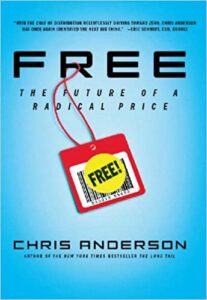 The idea that a service can be offered profitably, even if not charged for directly, is not new. As detailed in Chris Anderson’s book “Free”, the use of various “freemium” models has existed for a long time. From Gillette that famously made its money by selling cheap razors (or giving them away for free) and charging for the blades, to Google’s engine for growth being heavily driven off its ‘free’ apps like Gmail and Google Maps (linked to advertising where it actually gets paid).
The idea that a service can be offered profitably, even if not charged for directly, is not new. As detailed in Chris Anderson’s book “Free”, the use of various “freemium” models has existed for a long time. From Gillette that famously made its money by selling cheap razors (or giving them away for free) and charging for the blades, to Google’s engine for growth being heavily driven off its ‘free’ apps like Gmail and Google Maps (linked to advertising where it actually gets paid).
Of course, the most straightforward approach is not to give anything away for ‘free’ at all, but to charge an upfront planning fee for the advisor’s (additional) upfront work… in exchange for a lower ongoing fee (as if the advisor is ‘fully’ paid for the initial work, the ongoing fee need ‘only’ cover the less-time-intensive ongoing services). Which would more directly align the profitability of clients in each and every year, instead of a model where financial planning clients are unprofitable early on, only to be made up by being highly profitable in later years.
For instance, in the earlier financial planning example, over the span of a 20+ year relationship, the advisor generates $91,964 of AUM revenue from one client (with an ongoing AUM fee of 1.0%), and has a cost of $38,430 (which includes the expense of financial planning), producing a lifetime profit of $53,534. If the advisor instead had a goal to generate this profit opportunity more evenly over the entire 20-year relationship, their initial year AUM and planning fees would need to rise to roughly $6,200 in the first year (given the substantial first-year costs), declining to an average of $4,520 for the next 4 years (as meeting time is reduced), and then winding down closer to $3,000 in the years thereafter (and slowly growing over time due to increasing AUM).
Which equates to an ongoing AUM fee of 0.87%, plus a separate planning fee of $4,000 in year 1 and $2,000 in years 2-5, before the fee becomes AUM-only during the ongoing years. (Though in the long run, that will still result in clients being slightly more profitable in later years, simply because a reduced AUM fee still grows at a faster rate with the markets than advisor staffing costs tend to rise with inflation.)
Notably, though, the end result is that because the typical advisory relationship extends so long, getting paid a ‘full’ financial planning fee upfront doesn’t allow the advisor to charge much less on an ongoing basis… as the additional financial planning fee of $4,000 in year 1 and $2,000 in years 2-5 still doesn’t do much to impact the long-term AUM fee that dropped from 1% to just 0.87% instead.
The caveat, though, is that from a business development perspective, it’s not clear how many more clients the advisory firm could really attract by dropping its ongoing AUM fee to 0.87%. (After all, if clients were that sensitive to AUM fees, Fidelity’s research wouldn’t show such consistency of a 1% AUM fee across such a wide range of service models!) Whereas, practically speaking, having an additional upfront planning fee of $4,000 – a 150% increase over an AUM-only advisor for the same client – almost certainly will dissuade at least some clients from joining and result in them not becoming (long-term profitable) clients in the first place!
Time Horizon And The Freemium Model Of Bundled Financial Planning
When it comes to financial planning, the challenge of charging separately is that it makes the cost highly salient. Clients are acutely aware they’re paying, which makes them ask about the value they’ll get, which unfortunately is hard for most advisors to articulate. And thus, advisors who charge separately often get clients who ‘opt out’ of financial planning altogether, which ironically means the clients end out valuing the financial planning even less (because they never experience it at all!). Maybe they would have liked it, but they aren’t certain enough to pay upfront. Yet if they don’t, then they may not retain as well over time, either!
By contrast, a 'freemium” model that includes financial planning bundled to AUM fees makes the cost less salient, and it shifts the default. Now, it’s “You’re already paying for planning because it’s included in your fee. Are you sure you don’t want to use it?” The good news about this approach is that it’s much more likely to engage people by not having a separate cost barrier. The bad news is that, as the advisor, you’ll also get more people who ‘kick the tires’ and don’t take the planning seriously. As, ironically, the one upshot to charging separately for financial planning is that, while the upfront cost may turn a lot of people away, it does at least ensure those who pay tend to be more serious!
Nonetheless, to the extent that the planning services are engaged – even if just partially – and it improves long-term retention, the key point is to recognize that the planning is profitable and is paid for. It’s just paid over time, ‘earned’ in the form of client retention and its subsequent profitability in the long run, rather than a separate upfront payment. Though advisory firms must be cautious to recognize this, too. It means your financial planning staff isn’t a ‘cost’ to be managed down; it’s an investment in client retention that needs to be nurtured!
Of course, some people may view it as a negative to say that costly financial planning upfront will be made up for with long-term profitability from AUM fees, and instead believe that clients should pay at the time for what they’re getting at the time… which means paying more in the early years, and less in the later years, to align with where the time is spent. And in point of fact, some firms are even experimenting with cutting AUM fees for long-term clients, in recognition that often those 'well-behaved’ long-term clients really are easier and less costly to service in the long run!
But the problem, again, is that larger upfront fees can still discourage utilization of financial planning altogether (for clients who opt out of a separate planning fee) or, worse, dissuade the prospect from becoming a client in the first place. Creating the ironic risk that the advisor actually sacrifices long-term profitability by trying to cut their fees in the long run (as in the process it creates too much focus on short-term profitability for the advisor, and short-term cost of the client).
In other words, firms which price their services to be profitable in every year can cause ‘sticker shock’ in the initial years (that have a higher price because of the greater investment of time to start the planning relationship) and actually be at a competitive disadvantage to firms that smooth the fees out over time. Or stated more simply: advisory firms that are confident in their long-term retention rates can use their patience with a longer time horizon to outcompete firms focused on short-term profitability and may dissuade their clients with the higher short-term costs.
Of course, this presumes the client has a portfolio to manage from which AUM fees can be assessed in the first place; if the client doesn’t have assets to manage, clearly standalone financial planning fees, and/or ongoing subscription/retainer fees, will be the only viable option to pay for financial planning services. Though in such cases, ongoing subscription/retainer fees face the same trade-off of more stable year-by-year versus uneven but long-term profit.
At a minimum, though, the key point is just to recognize that, as a business, it’s not necessary to maximize profit in each and every year of the business, as long as the business is profitable over the long run. Or viewed another way, there’s nothing wrong with running a business where a particular client is a little more profitable in some years and less in others, as long as they average out over time. (Which is still much better than the commission model, where profitable clients subsidize unprofitable ones; in this case, it’s the profitable years of a particular client that helps to subsidize the more time-intensive, less-profitable early years, which is arguably much fairer for any particular client.)
As a starting point, advisors can consider their own advisory firms. Do the clients who engage in financial planning retain more/longer than those who don’t? Is the gap large enough that it’s worthwhile to lower the price of financial planning, or even give it away for ‘free’ upfront, just to make it easier for more clients to actually do financial planning, and stay engaged because of the planning, where the business profits in the long run anyway?
So what do you think? Do you price separately for financial planning? How do you think about short-term versus long-run profitability of a client over time? Please share your own experiences and thoughts in the comments below!


